中国传统文化简介英文
介绍中国传统文化的理由英文作文
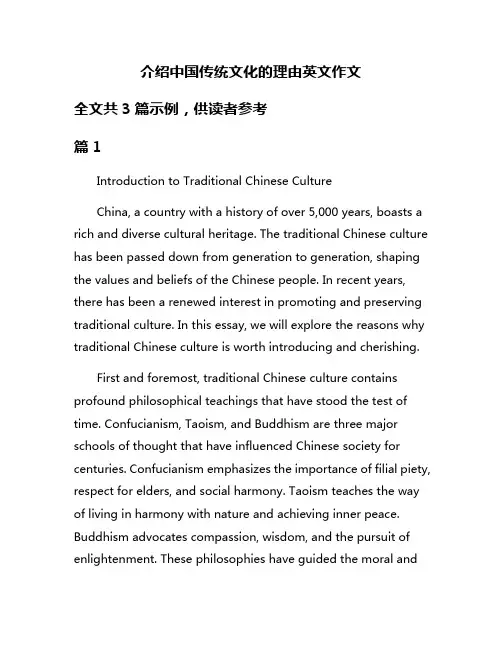
介绍中国传统文化的理由英文作文全文共3篇示例,供读者参考篇1Introduction to Traditional Chinese CultureChina, a country with a history of over 5,000 years, boasts a rich and diverse cultural heritage. The traditional Chinese culture has been passed down from generation to generation, shaping the values and beliefs of the Chinese people. In recent years, there has been a renewed interest in promoting and preserving traditional culture. In this essay, we will explore the reasons why traditional Chinese culture is worth introducing and cherishing.First and foremost, traditional Chinese culture contains profound philosophical teachings that have stood the test of time. Confucianism, Taoism, and Buddhism are three major schools of thought that have influenced Chinese society for centuries. Confucianism emphasizes the importance of filial piety, respect for elders, and social harmony. Taoism teaches the way of living in harmony with nature and achieving inner peace. Buddhism advocates compassion, wisdom, and the pursuit of enlightenment. These philosophies have guided the moral andethical behavior of the Chinese people for centuries, shaping their values and beliefs.Secondly, traditional Chinese culture is characterized by its emphasis on harmony and balance. The concept of yin and yang, which represents the dualistic nature of the universe, is central to Chinese philosophy. The idea of balance between opposites is reflected in various aspects of Chinese culture, such as traditional Chinese medicine, Feng Shui, and martial arts. Traditional Chinese medicine seeks to restore the balance of qi, or vital energy, in the body through acupuncture, herbal remedies, and other healing practices. Feng Shui is the art of arranging living spaces to promote balance and harmony. Martial arts, such as Tai Chi and Kung Fu, emphasize the balance of body and mind through disciplined practice.Furthermore, traditional Chinese culture is known for its rich artistic traditions, including calligraphy, painting, poetry, and music. Chinese calligraphy is considered a form of meditation and self-expression, with each brushstroke reflecting the artist's state of mind. Traditional Chinese painting often features landscapes, flowers, and birds, conveying the beauty of nature and the artist's emotional response to it. Chinese poetry is known for its lyrical beauty and emotional depth, with poets likeLi Bai and Du Fu achieving fame for their timeless verses. Traditional Chinese music, such as the guqin and pipa, is characterized by its soothing melodies and expressive qualities.In addition, traditional Chinese culture is renowned for its culinary traditions, which include a wide variety of dishes and cooking techniques. Chinese cuisine is characterized by its use of fresh ingredients, balanced flavors, and distinct regional styles. The art of Chinese cooking involves a combination of techniques, such as stir-frying, steaming, and braising, to create dishes that are both flavorful and visually appealing. Chinese food culture also emphasizes the importance of communal dining and sharing meals with family and friends, reflecting the value of hospitality and social harmony.In conclusion, traditional Chinese culture embodies a rich and diverse heritage that reflects the values, beliefs, and artistic achievements of the Chinese people. By introducing and cherishing traditional culture, we can gain a deeper understanding of Chinese history and society, as well as appreciate the beauty and wisdom of this ancient civilization. As China continues to modernize and globalize, it is essential to preserve and promote traditional culture as a source of inspiration and identity for future generations. Let us celebratethe legacy of traditional Chinese culture and ensure that it continues to thrive in the modern world.篇2Reasons to Introduce Chinese Traditional CultureChinese traditional culture, rich in history and customs, is an essential part of the world's cultural heritage. It represents the values, beliefs, and practices that have shaped Chinese society for thousands of years. There are several reasons why it is important to introduce and preserve Chinese traditional culture.Firstly, Chinese traditional culture is a valuable source of wisdom and inspiration. Throughout history, Chinese philosophers, scholars, and artists have produced profound insights into human nature, society, and the natural world. The teachings of Confucius, for example, emphasize the importance of moral integrity, social harmony, and filial piety. Traditional Chinese poetry, calligraphy, and painting reflect a deep appreciation of nature, beauty, and virtue. By studying and practicing these cultural traditions, people can gain a deeper understanding of themselves and the world around them.Secondly, Chinese traditional culture is a testament to the creativity and ingenuity of the Chinese people. From theinvention of paper and printing to the development of silk and porcelain, Chinese civilization has made significant contributions to human progress and innovation. Traditional Chinese medicine, martial arts, and cuisine are admired around the world for their effectiveness, elegance, and complexity. By preserving and promoting these cultural achievements, we can celebrate the achievements of past generations and inspire future generations to build on their legacy.Thirdly, Chinese traditional culture is a bridge to the past and a foundation for the future. By preserving and transmitting cultural traditions, we can connect with our ancestors and preserve the collective memory of our society. This continuity helps to create a sense of belonging and identity, providing a source of strength and resilience in times of change and uncertainty. By learning about our cultural heritage, we can better appreciate the values and principles that have guided our society for generations and gain insight into how we can shape a better future.In conclusion, Chinese traditional culture is a treasure trove of wisdom, creativity, and heritage that deserves to be preserved and passed on to future generations. By studying and practicing traditional Chinese customs, beliefs, and arts, we can gain adeeper understanding of ourselves and the world around us, celebrate the achievements of our ancestors, and create a more vibrant and inclusive society. Ultimately, the preservation of Chinese traditional culture is not only a matter of cultural pride but also a vital part of our shared human heritage.篇3IntroductionChinese traditional culture has a long history and rich heritage that has been passed down through generations. It encompasses a wide range of aspects including philosophy, literature, art, music, cuisine, medicine, and customs. In recent years, there has been a renewed interest in China's traditional culture both domestically and internationally. In this essay, we will explore the reasons why Chinese traditional culture is worthy of attention and preservation.1. A Reflection of Chinese HistoryChinese traditional culture is deeply rooted in the country's long and storied history. It reflects the values, beliefs, and principles that have shaped Chinese society for centuries. By studying traditional Chinese culture, we can gain a better understanding of the country's past, and how it has influencedthe present. From ancient philosophies such as Confucianism and Daoism to classical literature such as the poetry of Li Bai and Du Fu, Chinese traditional culture offers a window into the soul of the nation.2. A Source of Wisdom and InspirationChinese traditional culture is a wellspring of wisdom and inspiration. It offers valuable insights into human nature, morality, and the meaning of life. By exploring traditional Chinese philosophy and literature, we can learn from the experiences and teachings of sages and scholars who have grappled with the same existential questions that we face today. Chinese traditional culture encourages introspection,self-improvement, and moral growth, which are timeless and universal aspirations.3. A Treasure Trove of Artistic ExpressionChinese traditional culture is renowned for its artistic achievements in various domains such as calligraphy, painting, music, dance, and crafts. The exquisite beauty and craftsmanship of traditional Chinese art forms have captivated audiences around the world. From the delicate brushstrokes of Chinese calligraphy to the intricate designs of porcelain vases, traditional Chinese art represents the pinnacle of aesthetic excellence. Bystudying and appreciating Chinese traditional art, we can gain a deeper appreciation of beauty, culture, and history.4. A Foundation for Chinese IdentityChinese traditional culture plays a crucial role in shaping the identity and sense of belonging of the Chinese people. It provides a shared heritage and common values that unify individuals across different regions and generations. By preserving and promoting Chinese traditional culture, we can strengthen national cohesion, foster a sense of pride and cultural identity, and promote social harmony. Chinese traditional culture is a source of strength and resilience that can help the Chinese people navigate the challenges of the modern world.ConclusionIn conclusion, Chinese traditional culture is a priceless heritage that deserves to be cherished, preserved, and passed on to future generations. It embodies the wisdom, creativity, and spiritual essence of the Chinese civilization, and has much to offer to the world. By exploring and celebrating Chinese traditional culture, we can gain a deeper understanding of the past, draw inspiration for the present, and build a brighter future for all. Let us treasure and promote China's traditional culture for the benefit of humanity as a whole.。
英文作文介绍中国传统文化
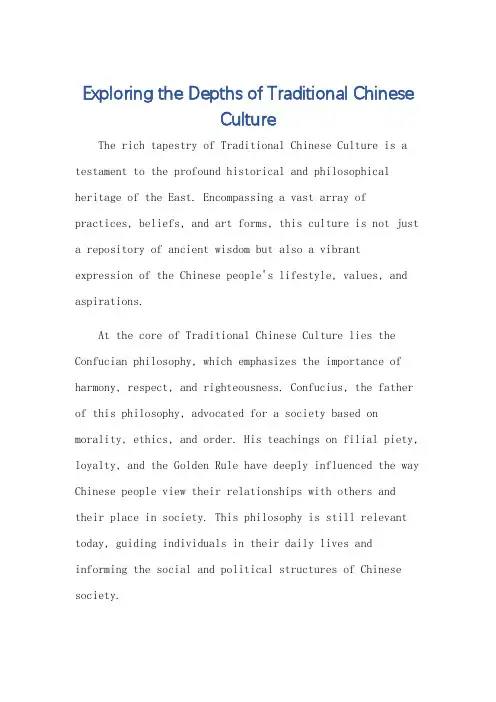
Exploring the Depths of Traditional ChineseCultureThe rich tapestry of Traditional Chinese Culture is a testament to the profound historical and philosophical heritage of the East. Encompassing a vast array of practices, beliefs, and art forms, this culture is not just a repository of ancient wisdom but also a vibrant expression of the Chinese people's lifestyle, values, and aspirations.At the core of Traditional Chinese Culture lies the Confucian philosophy, which emphasizes the importance of harmony, respect, and righteousness. Confucius, the father of this philosophy, advocated for a society based on morality, ethics, and order. His teachings on filial piety, loyalty, and the Golden Rule have deeply influenced the way Chinese people view their relationships with others and their place in society. This philosophy is still relevant today, guiding individuals in their daily lives and informing the social and political structures of Chinese society.Another important aspect of Traditional Chinese Culture is its rich artistic heritage. Chinese art, whether it be painting, calligraphy, pottery, or architecture, is renowned for its elegance, simplicity, and profound symbolism. The use of natural elements like water, stones, and flowers as motifs in art represents the Chineseaffinity with nature and their belief in the harmony of man with his surroundings. Calligraphy, in particular, is considered an extension of one's character and personality, with each stroke carrying deep meaning and emotional value. Music and dance are also integral to Chinese culture. Traditional Chinese instruments like the guqin, pipa, and drums create melodies that are both soothing and uplifting. These instruments, along with traditional dance forms like the dragon dance and lion dance, are often performed during festivals and special occasions, reflecting the joy and vitality of the Chinese people.The Chinese calendar is also a unique aspect of this culture, with each month, day, and season associated with specific meanings and celebrations. The Chinese New Year, for instance, is a time for family reunions, giving redenvelopes, and setting off fireworks to驱逐邪恶和迎来好运. These practices are deeply rooted in Chinese history and tradition, serving as a reminder of their cultural identity and heritage.In conclusion, Traditional Chinese Culture is a vast and diverse field that encompasses various aspects of life, from philosophy and art to music, dance, and festivals. This culture, with its unique blend of ancient wisdom and modern vitality, continues to inspire and influence people around the world, making it an integral part of global cultural heritage.**探寻中国传统文化的深厚底蕴**中国传统文化是一幅丰富多彩的织锦,见证了东方古老历史和哲学遗产的深厚底蕴。
中国传统文化(英文)
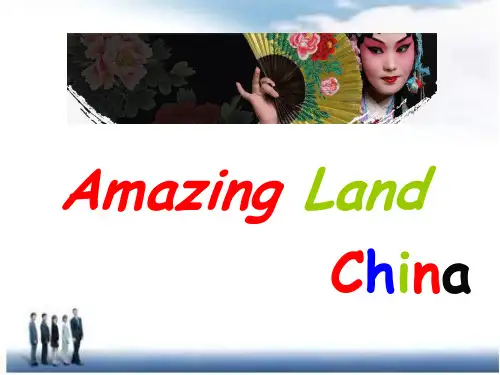
a pottery from
Yangshao Culture
As time passed, the technique became more and more consummate(至上的 ). Different kinds of pottery appeared in different times and regions. Yangshao Culture, 5,000 - 7,000 years ago to today, developed a technique for painted pottery. Qujialing Culture and Longshan Culture, dating back about 4,000 years ago, were known for their black pottery. During the Shang Dynasty (16th - 11th century BC) bronze vessels grew into somewhat(几分) of a status symbol(社会地位象征) ; common people, though, still used traditional clay pottery. Workshops of grey and white potters took the artistic features of bronze wares(商品) and decorated their articles ornately.
epower简介英语专业毕业论文英语学习辅导资料英语四六级考试研究生考试分类专业毕业论文精品教学课件课堂学习激趣课件毕业论文指导中小学课程辅导文化教育生活资源
介绍中国传统文化的英文作文
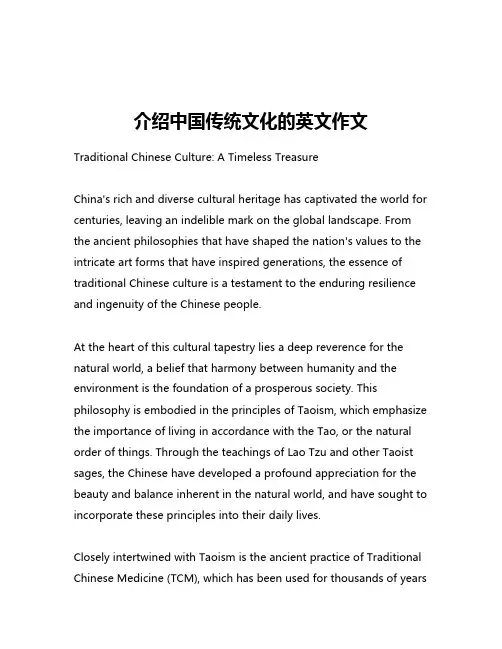
介绍中国传统文化的英文作文Traditional Chinese Culture: A Timeless TreasureChina's rich and diverse cultural heritage has captivated the world for centuries, leaving an indelible mark on the global landscape. From the ancient philosophies that have shaped the nation's values to the intricate art forms that have inspired generations, the essence of traditional Chinese culture is a testament to the enduring resilience and ingenuity of the Chinese people.At the heart of this cultural tapestry lies a deep reverence for the natural world, a belief that harmony between humanity and the environment is the foundation of a prosperous society. This philosophy is embodied in the principles of Taoism, which emphasize the importance of living in accordance with the Tao, or the natural order of things. Through the teachings of Lao Tzu and other Taoist sages, the Chinese have developed a profound appreciation for the beauty and balance inherent in the natural world, and have sought to incorporate these principles into their daily lives.Closely intertwined with Taoism is the ancient practice of Traditional Chinese Medicine (TCM), which has been used for thousands of yearsto promote holistic well-being. TCM practitioners believe that the body is a delicate ecosystem, and that by maintaining a harmonious balance of yin and yang, or opposing forces, one can achieve optimal physical and mental health. This holistic approach to healing has gained international recognition, with many people around the world turning to TCM as a complementary or alternative form of treatment.Another cornerstone of traditional Chinese culture is the art of calligraphy, a practice that has long been revered as a means of self-expression and spiritual cultivation. The graceful strokes of the calligrapher's brush, combined with the intricate characters that have evolved over millennia, have become a symbol of the country's rich literary heritage. From the elegant scrolls adorning the walls of imperial palaces to the simple inscriptions found in everyday life, calligraphy has the power to evoke a deep sense of cultural identity and artistic appreciation.Closely related to the art of calligraphy is the tradition of Chinese painting, which has produced some of the most breathtaking and iconic works of art in human history. Drawing inspiration from the natural world, Chinese painters have developed a unique style that emphasizes the interplay of light, shadow, and negative space, creating a sense of harmony and balance that is both visually stunning and spiritually uplifting. From the delicate brush strokes of the landscape scrolls to the bold, expressive strokes of the inkpaintings, Chinese art has the power to transport the viewer to a realm of profound beauty and contemplation.The influence of traditional Chinese culture can also be seen in the country's rich culinary heritage, which has evolved over thousands of years to reflect the diverse regional flavors and ingredients found throughout the vast and varied landscape. From the delicate dim sum of Cantonese cuisine to the fiery Sichuan hotpot, Chinese food is a celebration of the country's cultural diversity, blending the unique flavors and techniques of each region into a cohesive and harmonious whole.Underlying all of these cultural traditions is a deep respect for the values of family, community, and social harmony. The Confucian philosophy, which has been a guiding force in Chinese society for centuries, emphasizes the importance of filial piety, respect for elders, and the cultivation of virtuous character traits. These values have shaped the social fabric of China, fostering a sense of collective responsibility and mutual support that has enabled the country to weather countless challenges throughout its long and storied history.As the world becomes increasingly interconnected, the enduring appeal of traditional Chinese culture has only grown stronger. From the ancient wisdom of Taoism to the timeless beauty of Chinese art and architecture, the rich tapestry of this ancient civilizationcontinues to captivate and inspire people around the globe. By embracing and preserving these cultural traditions, China has not only strengthened its own national identity, but has also made an invaluable contribution to the shared heritage of humanity.。
中国传统文化英文介绍 chinese traditions
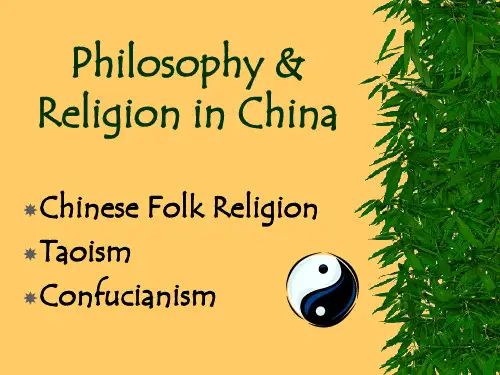
Chinese Metaphysics
Rising Falling
Movement of cosmic energies:
Expanding Contracting
Rotating
Represented by and expressed in the “five elements” of nature…
The ―Five Elements‖
Productive cycle
Fire Wood Earth
Water
ts‖
Destructive cycle
Wood
X
X
Fire
X
Earth Metal
Water
X
X
Chinese Metaphysics Concepts
Yin and Yang
YIN Negative force in nature Dark, cool, damp Femaleness Earth, moon, shadows YANG Positive force Light, bright, warmth, dryness Maleness Sun, Heaven
Everything (other than a few objects) is a combination of both forces. When they work in harmony, life is perfect.
Taoism
The Way of Harmony with Nature
– People are more than one religion without any conflicts – Oriental religions are complementary – A person might be both Buddhist and Confucian or Taoist and Confucian or all three, each serving a different function in one‘s life.
有关中国传统文化的英文作文三篇
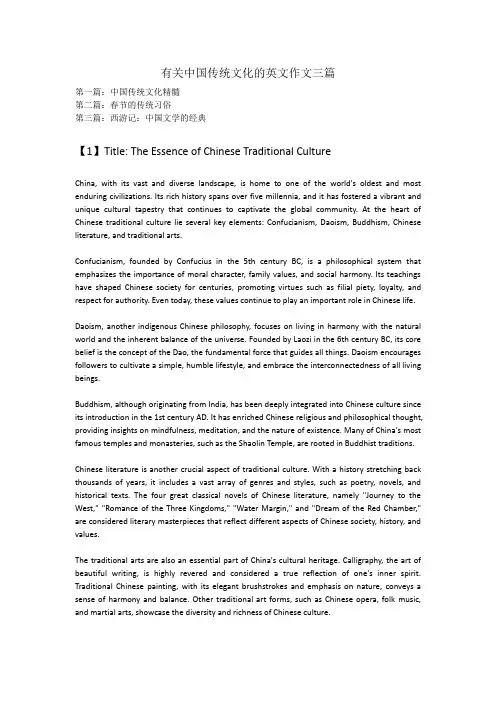
有关中国传统文化的英文作文三篇第一篇:中国传统文化精髓第二篇:春节的传统习俗第三篇:西游记:中国文学的经典【1】Title: The Essence of Chinese Traditional CultureChina, with its vast and diverse landscape, is home to one of the world's oldest and most enduring civilizations. Its rich history spans over five millennia, and it has fostered a vibrant and unique cultural tapestry that continues to captivate the global community. At the heart of Chinese traditional culture lie several key elements: Confucianism, Daoism, Buddhism, Chinese literature, and traditional arts.Confucianism, founded by Confucius in the 5th century BC, is a philosophical system that emphasizes the importance of moral character, family values, and social harmony. Its teachings have shaped Chinese society for centuries, promoting virtues such as filial piety, loyalty, and respect for authority. Even today, these values continue to play an important role in Chinese life.Daoism, another indigenous Chinese philosophy, focuses on living in harmony with the natural world and the inherent balance of the universe. Founded by Laozi in the 6th century BC, its core belief is the concept of the Dao, the fundamental force that guides all things. Daoism encourages followers to cultivate a simple, humble lifestyle, and embrace the interconnectedness of all living beings.Buddhism, although originating from India, has been deeply integrated into Chinese culture since its introduction in the 1st century AD. It has enriched Chinese religious and philosophical thought, providing insights on mindfulness, meditation, and the nature of existence. Many of China's most famous temples and monasteries, such as the Shaolin Temple, are rooted in Buddhist traditions.Chinese literature is another crucial aspect of traditional culture. With a history stretching back thousands of years, it includes a vast array of genres and styles, such as poetry, novels, and historical texts. The four great classical novels of Chinese literature, namely "Journey to the West," "Romance of the Three Kingdoms," "Water Margin," and "Dream of the Red Chamber," are considered literary masterpieces that reflect different aspects of Chinese society, history, and values.The traditional arts are also an essential part of China's cultural heritage. Calligraphy, the art of beautiful writing, is highly revered and considered a true reflection of one's inner spirit. Traditional Chinese painting, with its elegant brushstrokes and emphasis on nature, conveys a sense of harmony and balance. Other traditional art forms, such as Chinese opera, folk music, and martial arts, showcase the diversity and richness of Chinese culture.In conclusion, Chinese traditional culture is a multifaceted and enduring reflection of the nation's history, values, and beliefs. Its impact can be felt not only within China but also across the globe, as people from all walks of life are drawn to its unique charm and wisdom. As the world continues to evolve, Chinese traditional culture remains a source of inspiration and pride for the Chinese people and a testament to the resilience and creativity of human civilization.【2】Title: The Customs and Traditions of Chinese Spring FestivalThe Chinese Spring Festival, also known as Lunar New Year, is the most important and widely-celebrated holiday in China. It marks the beginning of the lunar calendar and is a time when families come together to welcome the new year with joy and prosperity. Rooted in centuries-old traditions, the Spring Festival embodies a rich tapestry of customs that have been passed down through generations. Here, we will delve into some of the most significant and fascinating practices associated with the festival.Preparations for the Spring Festival begin weeks in advance, with families cleaning their homes from top to bottom in a ritual known as "sweeping away the bad luck." This thorough cleaning is symbolic of driving away negative energy and making room for good fortune in the coming year. Homes are also adorned with red decorations, including lanterns, couplets, and paper cutouts, which represent happiness, prosperity, and good luck. Red, an auspicious color in Chinese culture, is believed to ward off evil spirits and bring good fortune.On the eve of the Spring Festival, families gather for a sumptuous reunion dinner, which is considered the most important meal of the year. The dinner table is laden with an array of dishes, each symbolizing a specific blessing for the new year. Fish, for example, represents abundance, while dumplings, with their-shaped like ancient gold ingots, symbolize wealth and prosperity. Family members indulge in these delicacies, sharing laughter and conversation as they usher in the new year together.One of the most well-known customs of the Spring Festival is the giving and receiving of red envelopes or "hongbao," which are filled with money. Traditionally, these envelopes are given by elders to younger family members as a symbol of their blessings and good wishes. The money inside the envelopes is believed to ward off evil spirits and bring good luck to the recipients in the coming year.Fireworks and firecrackers are also a prominent feature of the Spring Festival, as their loud explosions are believed to scare away evil spirits. Families and communities come together to light fireworks, filling the night sky with a dazzling spectacle of colors and sounds. This tradition has persisted for centuries, although some modern cities have introduced restrictions on fireworks to reduce air pollution and ensure safety.The Spring Festival celebrations culminate with the Lantern Festival, which falls on the fifteenthday of the first lunar month. During this time, streets and parks are illuminated with colorful lanterns, and people participate in riddle-solving games, enjoy traditional performances, and indulge in glutinous rice balls called "tangyuan," symbolizing family unity and togetherness.In conclusion, the customs and traditions of the Chinese Spring Festival reflect the richness and depth of Chinese culture. They embody the values of family, unity, and prosperity, while offering a fascinating glimpse into the beliefs and practices that have been passed down through generations. As the world becomes increasingly interconnected, the Spring Festival continues to captivate people of diverse cultures, who are drawn to its vibrant colors, tantalizing flavors, and profound symbolism.【3】Title: Journey to the West: A Classic of Chinese Literature"Journey to the West," also known as "Xiyouji" in Chinese, is one of the Four Great Classical Novels of Chinese literature. Written during the Ming Dynasty by Wu Cheng'en, the novel is a captivating blend of myth, legend, and adventure that has captured the hearts and imaginations of readers for centuries. This literary masterpiece not only provides a fascinating glimpse into Chinese history, culture, and beliefs, but also serves as a powerful allegory for spiritual growth and self-improvement.The story of "Journey to the West" is centered on the legendary pilgrimage of a Buddhist monk named Xuanzang, who travels from China to India in search of sacred Buddhist scriptures. Accompanying him on his perilous journey are four supernatural beings: Sun Wukong, the mischievous and resourceful Monkey King; Zhu Bajie, a pig-human hybrid with insatiable appetites for food and lust; Sha Wujing, a diligent and dependable river monster; and a white dragon horse that serves as Xuanzang's steed.Throughout the journey, Xuanzang and his companions encounter a myriad of challenges, including powerful demons, treacherous landscapes, and moral dilemmas. Each challenge serves as a test of their character, wisdom, and faith, ultimately shaping them into more virtuous and enlightened beings. While the narrative is filled with action, humor, and suspense, it also carries a deeper message about the importance of perseverance, compassion, and the transformative power of spiritual growth."Journey to the West" is notable for its rich and vivid portrayal of Chinese culture and mythology. The novel is steeped in Chinese folktales, legends, and Buddhist teachings, offering a unique window into the beliefs and values of ancient China. The characters in the story embody various aspects of human nature, such as courage, loyalty, cunning, and desire, providing valuable insights into the human condition.Furthermore, the novel has had a lasting impact on both Chinese and world literature. The character of Sun Wukong, the Monkey King, has become a symbol of rebellion, resourcefulness, and intelligence in Chinese culture. He has inspired countless adaptations, reinterpretations, andspin-offs, including the popular Japanese manga and anime series "Dragon Ball," which draws heavily from the character and themes of "Journey to the West."In conclusion, "Journey to the West" is a timeless classic of Chinese literature that continues to captivate and inspire readers from all walks of life. Its rich narrative, unforgettable characters, and profound messages about spiritual growth, resilience, and the human condition have solidified its status as a literary masterpiece. As the world becomes increasingly interconnected, the enduring appeal of "Journey to the West" is a testament to the power of stories to transcend cultural boundaries and unite people through the shared experience of imagination and wonder.。
中国传统文化介绍(英文版)(共19张PPT)
glue pudding
lanterns
guess lantern riddles
happiness
Qingming Festival
Text in here
Tomb sweeping
Text in here
Flying kites
The activity of people
Text inቤተ መጻሕፍቲ ባይዱhere
Dragon boat festival
Zongzi
Dragon Boat Race
Realgar wine(雄黄
酒)
Date
The dragon boat festival is celebrated on the fifth day of the fifth month of the Chinese lunar calendar.
看望老人
visiting the old
man
ascend a height
登高
apprec -iate mum
赏菊
Finally,we should treasure our traditional festivals, and don't regret it after they are lost. They are not just our holidays.
中国传统文化介绍(英文版)
Introduction to Chinese TraditionalCultureChina, with a history spanning over 5,000 years, boasts a rich and profound traditional culture that has shaped the country's identity and influenced countless aspects of daily life. This document aims to provide an overview of Chinese traditional culture, highlighting its key elements and their significance in Chinese society.1. Language and Literature2. Philosophy and ReligionChinese traditional culture is deeply rooted in Confucianism, Taoism, and Buddhism. Confucianism emphasizes the importance of moral integrity, respect for authority, and the pursuit of harmony in relationships. Taoism advocates for a simple, natural life and the pursuit of inner peace. Buddhism, introduced from India, has integrated with Chinese culture, influencing art, architecture, and everyday life.3. Art and CraftsmanshipChinese art is renowned for its exquisite craftsmanship and aesthetic appeal. Traditional Chinese painting, calligraphy, and porcelain are highly valued worldwide. The art of silk weaving, papermaking, and jade carving showcasesthe ingenuity and skill of Chinese artisans. Moreover, the practice of Feng Shui, which aims to harmonize the flow of energy in a space, reflects the Chinese belief in the interconnectedness of nature and human life.4. Festivals and CustomsChinese festivals are a vibrant display of the country's cultural heritage. The Spring Festival (Chinese New Year) is the most important holiday, featuring traditional activities such as dragon and lion dances, fireworks, and family reunions. Other notable festivals include the Lantern Festival, Dragon Boat Festival, and MidAutumn Festival, each with its unique customs and traditions.5. Traditional ClothingThe Hanfu, a traditional Chinese attire, reflects the elegance and diversity of Chinese culture. Characterized its flowing lines and vibrant colors, Hanfu represents different social status, occasions, and historical periods. The Tang suit and Qipao are also iconic examples of Chinesetraditional clothing, showcasing the beauty and grace of Chinese women.In conclusion, Chinese traditional culture is a treasure trove of wisdom, art, and values that continue to shape the lives of people in China and around the world. By exploringthese cultural elements, we can gain a deeper understandingof the Chinese perspective on life, nature, and humanity.6. Culinary DelightsChinese cuisine is a vital part of its traditional culture, renowned for its diversity and emphasis on harmonyin flavors and ingredients. The practice of using a pair of chopsticks is not only a dining custom but also a reflectionof Chinese philosophy. Signature dishes such as Peking duck, hot pot, dim sum, and Sichuan spicy tofu (Mapo tofu)represent the rich tapestry of regional cuisines within China. The art of tea making and tea ceremonies further illustratethe Chinese pursuit of balance and tranquility in daily life.7. Architecture and GardensChinese architecture is characterized its use of wood, intricate carvings, and upturned eaves. The Forbidden City in Beijing and the classical gardens of Suzhou are prime examples of Chinese architectural excellence. Thesestructures are not only beautiful but also embody theprinciples of Feng Shui and the concept of harmony between humanity and nature. The gardens, in particular, are designed to mimic natural landscapes, providing a serene environmentfor contemplation and relaxation.8. Music and DanceChinese traditional music, with its unique scales and instruments such as the guzheng (zither), erhu (fiddle), and pipa (lute), creates a distinctive sound that is both soothing and evocative. Chinese classical dance, often performed in colorful costumes with flowing movements, tells stories and expresses emotions, drawing from historical legends and folk tales. The Peking Opera, with its elaborate costumes, makeup, and singing styles, is a famous form of traditional Chinese performing art.9. Martial Arts10. Social EtiquetteChinese society places a strong emphasis on respect, modesty, and humility. The concept of "face" (mianzi) is crucial in social interactions, representing one's reputation and social standing. Traditional greetings, such as bowing or clasping hands, and the exchange of business cards with both hands, demonstrate the importance of etiquette in Chinese culture. The practice of giftgiving, with its specific customs and taboos, is also a reflection of the respect and consideration shown in relationships.In exploring the depths of Chinese traditional culture, one cannot help but be inspired its richness and the enduring legacy it has left on the world. It is a culturethat invites us to look inward, to appreciate the beauty in simplicity, and to find harmony in the world around us.11. Folklore and MythologyChinese folklore and mythology are a tapestry of stories and legends that have been passed down through generations. These tales often feature mythical creatures like the dragon, phoenix, and qilin, which symbolize power, prosperity, and good fortune. Stories such as "Journey to the West," "Water Margin," and "The Investiture of the Gods" are not only literary masterpieces but also reflect the moral values and cultural norms of ancient China. These myths and legends continue to influence modern Chinese literature, film, and popular culture.12. Traditional Medicine13. Family ValuesFamily is the cornerstone of Chinese society, and traditional values place a strong emphasis on filial piety and ancestor worship. Elders are respected for their wisdom and experience, and the concept of "family" extends beyond the nuclear unit to include extended relatives. The family name (surname) is a source of pride and identity, often passed down through generations with a sense of duty to honor one's ancestors. The importance of family is reflected in thecelebration of festivals, where family reunions are a central tradition.14. Education and the Art of LearningEducation has always been highly valued in Chinese culture, with a focus on the pursuit of knowledge and the cultivation of moral character. The ancient Chinese education system emphasized the Four Arts: qin (a string instrument), shu (calligraphy), hua (painting), and qi (the game of Go). Today, the Chinese education system continues to be rigorous, with a strong emphasis on academic achievement and the Confucian values of respect for teachers and the importance of learning.15. Ceremonies and RitualsChinese culture is rich with ceremonies and rituals that mark life's milestones, such as births, weddings, and funerals. These events are often steeped in tradition, with specific customs and rituals that have been followed for centuries. For instance, Chinese weddings are filled with symbolic gestures, such as the exchange of red envelopes (hongbao), the tea ceremony, and the wearing of traditional attire. These rituals are not only celebratory but also serve to reinforce cultural identity and continuity.In conclusion, the depth and breadth of Chinesetraditional culture are truly aweinspiring. It is a livingheritage that continues to evolve while maintaining its roots in ancient wisdom. By understanding and appreciating these cultural elements, we gain insight into the soul of a civilization that has shaped and continues to shape the world in countless ways.。
英文版中国传统文化
英文版中国传统文化(中英文实用版)Title: The Essence of Chinese Traditional CultureIn the vast tapestry of global culture, China's traditional heritage stands as a towering pillar, brimming with the wisdom and creativity of an ancient civilization. From the elegant strokes of calligraphy to the poetic harmony of tea ceremonies, this unique cultural expression has captivated the world for millennia.标题:中国传统文化之精髓在全球文化的斑斓大观中,中国传统文化如同一根耸立的巨柱,充满了古老文明的智慧与创造力。
从书法的优雅笔触到茶艺的诗意和谐,这种独特的文化表达形式已经令世界着迷数千年。
The philosophy of yin and yang, deeply rooted in Chinese thought, reflects a balance and harmony that is visible in every aspect of traditional culture. From the culinary art of Chinese cuisine to the precision of martial arts, this pursuit of equilibrium resonates with the core values of Chinese society.阴阳哲学,深植于中国思想之中,反映了一种平衡与和谐,这种平衡在传统文化的每一个方面都可见一斑。
中国传统文化介绍(英文版)
栏目索引与介绍•当前位置: 主页/•中外文化/中国文化随着中国加入世界贸易组织,中国将进一步对外开放,中国经济与世界经济更加融合。
因此,将中华民族悠久的历史和灿烂的文化介绍给世界各国人民是所有英语爱好者应尽的责任。
开辟这个栏目,就是为了适应对外宣传的需要。
我们将在此介绍中国历史、音乐、绘画、考古、旅游、经济、宗教等方面的情况。
那些从事中国文化教学与研究的师生会在这里找到一些参考资料和英语表达方式。
中国文化知识漫谈(中文)中国文化美国行(新闻报道与背景介绍)Culture Relics文化古迹Travel Features旅游Wushu/Qigong武术与气功Opera/Theatre戏曲Galleries/Museums美术馆与博物馆Peking Opera中国京剧Events/Festivals节日与民俗Local Opera中国地方戏Chinese New Year's Day中国新年来历与24节气Dance Drama and Ballet中国舞剧与芭蕾Traditions of Chinese New Year中国新年除夕习俗Modern Chinese Drama中国话剧Do's and Don'ts of Chinese New Year 中国新年禁忌Acrobatics, Puppet and Shadow Shows杂技、木偶戏与皮影The History of Lion Dance中国舞狮Quyi Performances中国曲艺表演The History of Fireworks中国鞭炮Paintings/Handicrafts绘画与工艺品Lantern Festival元宵节成语典故一 (三国演义、西游记)Brithday of Confucius孔子生日成语典故二Birthday of Mazoo妈祖生日成语典故三Dragon Boat Festival端午节成语典故四Moon Festival中秋节中国古代简史中国文学(包括古文、近代、现代与当代文学以及文化传统,作家传记)中国诗歌英译 (请综合训练中翻译技巧栏目)中国旅游《旅游英语》网络课程中国旅游十大特色中国西藏北京景点天坛中国美食故宫中国十二生肖:12 Taditional Zodiacs M usic音乐RAM HORSE Solo Recordings中国音乐独奏MONKEY ROOSTER CollectedRecordings中国音乐集锦SNAKE DRAGON TraditionalChinese中国传统乐器与音乐InstrumentalmusicDOG PIG Classical Music中国古典音乐OX TIGERRABBIT RAT中国文化知识漫谈(一)文化的含义什么叫文化?《易经》上说:“观乎天文,以察时变,观乎人文,以化成天下。
- 1、下载文档前请自行甄别文档内容的完整性,平台不提供额外的编辑、内容补充、找答案等附加服务。
- 2、"仅部分预览"的文档,不可在线预览部分如存在完整性等问题,可反馈申请退款(可完整预览的文档不适用该条件!)。
- 3、如文档侵犯您的权益,请联系客服反馈,我们会尽快为您处理(人工客服工作时间:9:00-18:30)。
Chinese Zodiac and
Dragon
Chinese Zodiac
The Chinese Zodiac (生肖) consists of twelve animal signs, each representing a year according to the lunar calendar. The twelve animal signs are: Rat; Ox; Tiger; Rabbit; Dragon; Snake; Horse; Sheep; Monkey; Chicken; Dog and Pig.
Emperor Huang and Yan
Every year, on the Tomb-sweeping Day (usually on April 5th), thousands of Chinese people come back from all over the world to the tomb of their oldest ancestors in Shaanxi province to participate the annual memorial ceremony..
This year is the year of Monkey!!!
What is your Chinese Zodiac?
Dragon
We also believe that we are the descendants of the Dragon. The images of the mythic Dragon can be found on m
The dragon has nine sons. The nine dragon have different themes, and they all have different versions too. One version is: The 1st son loves music. The head of Number 1 son becomes a decoration for music instrument, such as two-stringed bowed violin (囚牛 huqin). The 2nd son loves fighting. Many different handles of weapons have the symbol of Number 2 son.(睚眦 yazi) The 3rd son loves adventure and keeping guard. He has prestige and is the symbol of safety, harmony and peace.(嘲风 chaofeng) The 4th son loves howling. The image of Number 4 son can be found on the big bells. It is a symbol of protection and alertness.(蒲牢 pulao) The 5th son loves quietness, sitting, fire and smoke. His image is often found in temples, such as on incense burners.(狻猊 suan ni)
A Brief Introduction to Chinese Traditional Culture
中国传统文化简介
❖
Emperor Yan and Huang(炎帝和黄帝) The Chinese Zodiac and Dragon(十二生肖和龙)
Clothing(服装) Chinese Inventions(中国的发明) Famous Chinese People (中国的名人)
The order of the animals is often explained with a folk-tale about how the animals were summoned (召唤)to heaven by the Jade Emperor.
The dragon, as the only animal of the twelve that could fly, was expected to arrive first. But the dragon’s nature is to be helpful, and he stopped to help some villagers and then the rabbit, so he was the fifth animal to arrive for the Jade King's feast.
Dragon
The 6th son has the power of strength. He loves to carry heavy stuff to show off his magic energy. He is a symbol of longevity and good luck.(霸下 ba xia)
Emperor Yan and Huang
Emperor Huang and Yan
China has a long history of More than 5,000 years of civilization! The Emperor Yan and Huang are considered as our common ancestors.
The 7th son loves to seek justice. Chinese like to apply his symbol around law, court, or jail.(狴犴bi gan)
The 8th son loves literature. Chinese like to put the 8th son as a symbol around steles(石碑). When used in this way, it is a symbol of knowledge or education.(负质 fu zhi)
